Blog
How Bad Are Flip Flops for Your Feet?
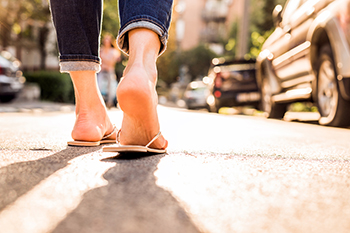
Many people choose to wear flip-flops because of their simplicity to slide on and off as well as the various colors and styles they can be found in. Despite their ease, research has indicated they can be harmful to the feet if they are frequently worn. The feet can generally ache from wearing flip-flops too much, and this can be a result of the lack of support they are often designed with. Additionally, they can be worn on dirty floors and in public swimming areas, and bacteria can accumulate on these types of shoes. This can possibly lead to getting a skin infection which may become a serious staph infection. Blisters can form on the feet if flip-flops are worn daily, and this may be from how unsteady they fit on the feet. Plantar fasciitis may be an uncomfortable foot condition that can develop from little or no arch support, and may lead to severe heel pain. If you have questions about flip flops and what type of foot conditions they may cause, please consult with a podiatrist who can answer any concerns you may have.
Flip-flops can cause a lot of problems for your feet. If you have any concerns about your feet or ankles, contact Shaun J. Limon, DPM and Lisa Griffith-Limon, DPM from Limons Foot & Ankle Care. Our doctors will assist you with all of your foot and ankle needs.
Flip-Flops and Feet
Flip-flops have managed to become a summer essential for a lot of people. While the shoes may be stylish and easy to slip on and off, they can be dangerous to those who wear them too often. These shoes might protect you from fungal infections such as athlete’s foot, but they can also give you foot pain and sprained ankles if you trip while wearing them.
When Are They Okay to Wear?
Flip-flops should only be worn for very short periods of time. They can help protect your feet in places that are crawling with fungi, such as gym locker rooms. Athlete’s foot and plantar warts are two common fungi that flip-flops may help protect your feet against.
Why Are They Bad for My Feet?
These shoes do not offer any arch support, so they are not ideal for everyday use. They also do not provide shock absorption or heel cushioning which can be problematic for your feet. Additionally, you may suffer from glass cuts, puncture wounds, and stubbed toes since they offer little protection for your feet.
More Reasons Why They Are Bad for Your Feet
- They Slow You Down
- May Cause Blisters and Calluses
- Expose Your Feet to Bacteria
If you have any questions, please feel free to contact our offices located in Bradenton and Lakewood Ranch, FL . We offer the newest diagnostic and treatment technologies for all your foot care needs.
Are You Suffering From Ingrown Toenails?
Ankle Stretches
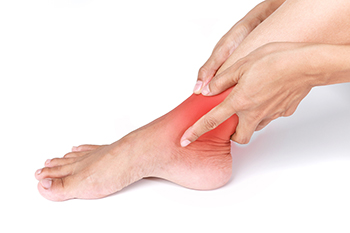
Many different individuals might experience some kind of ankle pain or stiffness at some point in their lives. There are many different causes and types of ankle pain. However, if the ankle is feeling stiff, sore, or painful, gently stretching the ankle may be beneficial for some people. An individual might consider performing ankle circles where, in a seated position with one leg crossed over another, you move the foot off of the ground in a circle. Another potential stretch is known as the towel stretch where a person sits on the ground with their legs stretched out in front of them. Then, the person wraps a towel around the bottom of the feet, and gently and repeatedly pulls the towel toward themselves. Of course, it is always a good idea to consult with a medical professional before performing stretches. Contact a podiatrist today to see if you can mitigate your ankle pain or stiffness by performing any of these stretches.
Ankle pain can be caused by a number of problems and may be potentially serious. If you have ankle pain, consult with Shaun J. Limon, DPM and Lisa Griffith-Limon, DPM from Limons Foot & Ankle Care. Our doctors will assess your condition and provide you with quality foot and ankle treatment.
Ankle pain is any condition that causes pain in the ankle. Due to the fact that the ankle consists of tendons, muscles, bones, and ligaments, ankle pain can come from a number of different conditions.
Causes
The most common causes of ankle pain include:
- Types of arthritis (rheumatoid, osteoarthritis, and gout)
- Ankle sprains
- Broken ankles
- Achilles tendinitis
- Achilles tendon rupture
- Stress fractures
- Bursitis
- Tarsal tunnel syndrome
- Plantar fasciitis
Symptoms
Symptoms of ankle injury vary based upon the condition. Pain may include general pain and discomfort, swelling, aching, redness, bruising, burning or stabbing sensations, and/or loss of sensation.
Diagnosis
Due to the wide variety of potential causes of ankle pain, podiatrists will utilize a number of different methods to properly diagnose ankle pain. This can include asking for personal and family medical histories and of any recent injuries. Further diagnosis may include sensation tests, a physical examination, and potentially x-rays or other imaging tests.
Treatment
Just as the range of causes varies widely, so do treatments. Some more common treatments are rest, ice packs, keeping pressure off the foot, orthotics and braces, medication for inflammation and pain, and surgery.
If you have any questions, please feel free to contact our offices located in Bradenton and Lakewood Ranch, FL . We offer the newest diagnostic and treatment technologies for all your foot care needs.
What Causes Foot Pain in Toddlers?
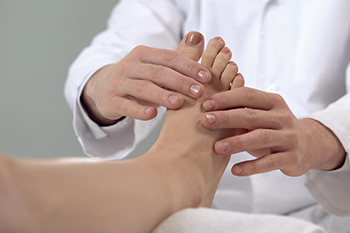
If your toddler seems to have foot pain, he or she may not be able to sleep and will often complain about walking or putting on shoes. Sometimes their foot discomfort is nothing more than growing pains that begin in the late part of the second year of life and last until age 4. Toddlers can also feel foot pain due to muscle soreness or overuse from zealous running, jumping, and climbing. However, other things may also be brewing that cause foot pain in these youngsters. Flatfoot is when the foot does not develop a normal arch. It is normal for babies to have flat feet, but if it continues beyond age 2 or 3 and the feet have taken on their shape, it can cause pain in the arch, heel, ankle, leg, hip, and back, as well as rolling of the foot. A child may also suffer from restless leg syndrome. This is a neurological condition where sensations are felt in the legs and feet. While the cause is unknown, this is found more often in small children and early walkers with allergic conditions, asthma, and eczema. It may also be due to a particular medication, anemia, or childhood diabetes. Toddler foot pain may be due to a nutritional deficiency, such as dehydration, low potassium, and magnesium. Sever’s disease is a condition that develops from an injury to the growth plate in the heel. The growth plate becomes inflamed and may cause pain until the feet have finished growing. Contact a podiatrist if your child’s foot pain persists or worsens. This professional can see if one of these conditions is present that needs attention and treatment.
The health of a child’s feet is vital to their overall well-being. If you have any questions regarding foot health, contact Shaun J. Limon, DPM and Lisa Griffith-Limon, DPM of Limons Foot & Ankle Care. Our doctors can provide the care you need to keep you pain-free and on your feet.
Tips for Keeping Children's Feet Healthy
- Make sure their shoes fit properly
- Look for any signs of in-toeing or out-toeing
- Check to see if they have Clubfoot (condition that affects your child’s foot and ankle, twisting the heel and toes inward) which is one of the most common nonmajor birth defects.
- Lightly cover your baby’s feet (Tight covers may keep your baby from moving their feet freely, and could prevent normal development)
- Allow your toddler to go shoeless (Shoes can be restricting for a young child’s foot)
- Cut toenails straight across to avoid ingrown toenails
- Keep your child’s foot clean and dry
- Cover cuts and scrapes. Wash any scratches with soap and water and cover them with a bandage until they’ve healed.
If you have any questions, please feel free to contact our offices located in Bradenton and Lakewood Ranch, FL . We offer the newest diagnostic and treatment technologies for all your foot care needs.
Do Your Child's Feet Hurt?
Blisters on the Bottom of the Feet
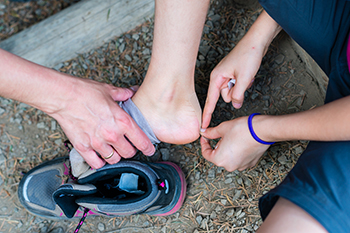
Blisters can occur on the bottom of the feet for different reasons. Causes of foot blisters include dyshidrotic eczema from seasonal allergies or stress, friction from repetitive rubbing of the feet on shoes and/or socks that are too tight, or athlete’s foot infections. However, injuries or underlying medical conditions can also lead to foot blisters. Blisters can produce issues ranging from mild discomfort to severe pain and bleeding. It is important not to try to burst a blister. If it does burst, it will likely produce more discomfort. If you have foot blisters and you do not know the cause, they are becoming worse, or not healing, seek medical advice. Diabetics should take particular heed of this advice because if they suffer from neuropathy, they may not notice that a blister may turn into an ulcer and possibly cause dangerous complications. See a podiatrist for the proper diagnosis and care of blisters.
Blisters are prone to making everyday activities extremely uncomfortable. If your feet are hurting, contact Shaun J. Limon, DPM and Lisa Griffith-Limon, DPM of Limons Foot & Ankle Care. Our doctors can provide the care you need to keep you pain-free and on your feet.
Foot Blisters
Foot blisters develop as a result of constantly wearing tight or ill-fitting footwear. This happens due to the constant rubbing from the shoe, which can often lead to pain.
What Are Foot Blisters?
A foot blister is a small fluid-filled pocket that forms on the upper-most layer of the skin. Blisters are filled with clear fluid and can lead to blood drainage or pus if the area becomes infected.
How Do Blisters Form?
Blisters on the feet are often the result of constant friction of skin and material, usually by shoe rubbing. Walking in sandals, boots, or shoes that don’t fit properly for long periods of time can result in a blister. Having consistent foot moisture and humidity can easily lead to blister formation.
Prevention & Treatment
It is important to properly care for the affected area in order to prevent infection and ease the pain. Do not lance the blister and use a Band-Aid to provide pain relief. Also, be sure to keep your feet dry and wear proper fitting shoes. If you see blood or pus in a blister, seek assistance from a podiatrist.
If you have any questions, please feel free to contact our offices located in Bradenton and Lakewood Ranch, FL . We offer the newest diagnostic and treatment technologies for all your foot care needs.
Do I Have an Ankle Fracture?

An ankle fracture means that one or more of the medial, lateral, or posterior malleolus (the bony projections on either side of the ankle) is broken. Dislocation of the ankle joint can result from an ankle fracture. Usually, when a patient breaks an ankle, they will experience pain, swelling, and an inability to bear weight on the affected foot. There may be a pop when the ankle breaks, and it may appear deformed. Those with osteoporosis, a history of frequent falls, or a compromised vascular system are more at risk for ankle fractures, as are those who have frequently participated in sports. An X-ray, CT scan, or MRI will confirm a broken ankle diagnosis. If you think you have broken your ankle, it is suggested that you see a podiatrist who can recommend the best treatment options for you.
Broken ankles need immediate treatment. If you are seeking treatment, contact Shaun J. Limon, DPM and Lisa Griffith-Limon, DPM from Limons Foot & Ankle Care. Our doctors can provide the care you need to keep you pain-free and on your feet.
Broken Ankles
A broken ankle is experienced when a person fractures their tibia or fibula in the lower leg and ankle area. Both of these bones are attached at the bottom of the leg and combine to form what we know to be our ankle.
When a physician is referring to a break of the ankle, he or she is usually referring to a break in the area where the tibia and fibula are joined to create our ankle joint. Ankles are more prone to fractures because the ankle is an area that suffers a lot of pressure and stress. There are some obvious signs when a person experiences a fractured ankle, and the following symptoms may be present.
Symptoms of a Fractured Ankle
- Excessive pain when the area is touched or when any pressure is placed on the ankle
- Swelling around the area
- Bruising of the area
- Area appears to be deformed
If you suspect an ankle fracture, it is recommended to seek treatment as soon as possible. The sooner you have your podiatrist diagnose the fracture, the quicker you’ll be on the way towards recovery.
If you have any questions, please feel free to contact our offices located in Bradenton and Lakewood Ranch, FL . We offer the newest diagnostic and treatment technologies for all your foot care needs.
Wounds That Don't Heal Need to Be Checked
Foot Pain and Metatarsalgia

The name given to a pain in the ball of the foot is metatarsalgia. The five long bones on the bottom of the feet are the metatarsals, and they connect the ankle to the toes. This type of foot pain can feel like a burning sensation or may range from a dull ache to shooting pain. The area that is affected is where the second, third, and fourth toes meet the ball of the foot and may feel worse when walking or running. Some medical reasons that metatarsalgia may develop include arthritis, hammertoe, bunions, or the painful condition known as gout. Additional causes are wearing shoes that do not fit correctly, being overweight, and participating in high-impact sporting activities. Mild relief may be found when elevating the affected foot as often as possible, and it may help to wear shoes that have shock-absorbing insoles. Additionally, many people choose to stretch their Achilles tendon, exercise the ankle, and wear shoes that have flat or low heels. If you have pain in your foot and would like a proper diagnosis and treatment plan, please confer with a podiatrist.
Foot Pain
Foot pain can be extremely painful and debilitating. If you have a foot pain, consult with Shaun J. Limon, DPM and Lisa Griffith-Limon, DPM from Limons Foot & Ankle Care. Our doctors will assess your condition and provide you with quality foot and ankle treatment.
Causes
Foot pain is a very broad condition that could be caused by one or more ailments. The most common include:
- Bunions
- Hammertoes
- Plantar Fasciitis
- Bone Spurs
- Corns
- Tarsal Tunnel Syndrome
- Ingrown Toenails
- Arthritis (such as Gout, Rheumatoid, and Osteoarthritis)
- Flat Feet
- Injury (from stress fractures, broken toe, foot, ankle, Achilles tendon ruptures, and sprains)
- And more
Diagnosis
To figure out the cause of foot pain, podiatrists utilize several different methods. This can range from simple visual inspections and sensation tests to X-rays and MRI scans. Prior medical history, family medical history, and any recent physical traumatic events will all be taken into consideration for a proper diagnosis.
Treatment
Treatment depends upon the cause of the foot pain. Whether it is resting, staying off the foot, or having surgery; podiatrists have a number of treatment options available for foot pain.
If you have any questions, please feel free to contact our offices located in Bradenton and Lakewood Ranch, FL . We offer the newest diagnostic and treatment technologies for all your foot care needs.
Foot Taping May Provide Relief from Painful Plantar Fasciitis
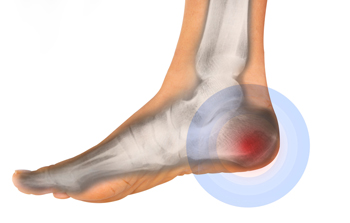
Plantar fasciitis is a form of heel pain that is quite common. It occurs when the plantar fascia tissue that connects the heel with the toes becomes damaged and sometimes torn through overuse. Plantar fasciitis causes pain and swelling in the tissue, which is worse in the morning, because the plantar fascia tissue tightens while you are sleeping. A podiatrist deals with cases of plantar fasciitis every day and has many forms of treatments to alleviate the painful symptoms of this condition. Your podiatrist may tape your foot with a rigid adhesive sports strapping tape to reduce the stretch and strain on your plantar fascia. Foot taping is a very safe treatment method, which sometimes may provide immediate relief. If you have heel pain, get your condition diagnosed by a podiatrist and discuss whether foot taping might be an appropriate treatment method.
Plantar fasciitis is a common foot condition that is often caused by a strain injury. If you are experiencing heel pain or symptoms of plantar fasciitis, contact Shaun J. Limon, DPM and Lisa Griffith-Limon, DPM from Limons Foot & Ankle Care. Our doctors can provide the care you need to keep you pain-free and on your feet.
What Is Plantar Fasciitis?
Plantar fasciitis is one of the most common causes of heel pain. The plantar fascia is a ligament that connects your heel to the front of your foot. When this ligament becomes inflamed, plantar fasciitis is the result. If you have plantar fasciitis you will have a stabbing pain that usually occurs with your first steps in the morning. As the day progresses and you walk around more, this pain will start to disappear, but it will return after long periods of standing or sitting.
What Causes Plantar Fasciitis?
- Excessive running
- Having high arches in your feet
- Other foot issues such as flat feet
- Pregnancy (due to the sudden weight gain)
- Being on your feet very often
There are some risk factors that may make you more likely to develop plantar fasciitis compared to others. The condition most commonly affects adults between the ages of 40 and 60. It also tends to affect people who are obese because the extra pounds result in extra stress being placed on the plantar fascia.
Prevention
- Take good care of your feet – Wear shoes that have good arch support and heel cushioning.
- Maintain a healthy weight
- If you are a runner, alternate running with other sports that won’t cause heel pain
There are a variety of treatment options available for plantar fasciitis along with the pain that accompanies it. Additionally, physical therapy is a very important component in the treatment process. It is important that you meet with your podiatrist to determine which treatment option is best for you.
If you have any questions, please feel free to contact our offices located in Bradenton and Lakewood Ranch, FL . We offer the newest diagnostic and treatment technologies for all your foot care needs.
More...
It's Time for Beautiful Feet
Tendonitis in the Foot and Ankle
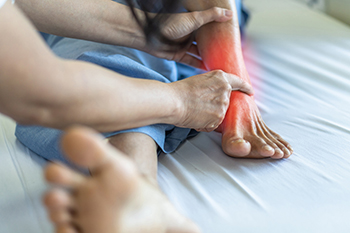
Tendons are thick bands of tissue that connect muscles to bones. The feet and ankles have a large number of tendons, any of which can become inflamed, a condition known as tendonitis. The main cause of tendonitis is overuse from repetitive movement. For that reason tendonitis is especially common to runners, because if a tendon is made to work too hard or too long it can develop tears. Other causes of foot and ankle tendonitis include an abnormal foot structure like flat feet or high arches, an injury, or a medical condition, such as gout or rheumatoid arthritis. The primary symptom of tendonitis in the foot or ankle is sharp, burning pain, often followed by swelling and stiffness. In many cases, tendonitis can be treated successfully, though the recovery period may take weeks, or even months. The first way to begin the process is to rest the painful area and cease the activity that caused it. If pain continues, or worsens, it is a good idea to visit a podiatrist for a thorough exam. The doctor may prescribe a variety of treatment options to ease the inflammation, including medication, orthotics, and exercises.
Foot and ankle trauma is common among athletes and the elderly. If you have concerns that you may have experienced trauma to the foot and ankle, consult with Shaun J. Limon, DPM and Lisa Griffith-Limon, DPM from Limons Foot & Ankle Care. Our doctors will assess your condition and provide you with quality foot and ankle treatment.
Foot and ankle trauma cover a range of injuries all over the foot; common injuries include:
- Broken bones
- Muscle strains
- Injuries to the tendons and ligaments
- Stress fractures
Symptoms
Symptoms of foot and ankle injuries vary depending on the injury, but more common ones include:
- Bruising
- Inflammation/ Swelling
- Pain
Diagnosis
To properly diagnose the exact type of injury, podiatrists will conduct a number of different tests. Some of these include sensation and visual tests, X-rays, and MRIs. Medical and family histories will also be taken into account.
Treatment
Once the injury has been diagnosed, the podiatrist can than offer the best treatment options for you. In less severe cases, rest and keeping pressure off the foot may be all that’s necessary. Orthotics, such as a specially made shoes, or immobilization devices, like splints or casts, may be deemed necessary. Finally, if the injury is severe enough, surgery may be necessary.
If you have any questions, please feel free to contact our offices located in Bradenton and Lakewood Ranch, FL . We offer the newest diagnostic and treatment technologies for all your foot care needs.
Various Reasons That Flat Feet Can Occur

The medical condition known as flat feet exists as a result of little or no arch in the foot. It is easy to notice and can be seen by standing on the floor with the entire foot lying flat. It can be referred to as pes planus, or fallen arches, and most babies are born with this condition. It generally disappears as most arches are fully developed by the teenage years. There is a small percentage of patients who have flat feet throughout adulthood that may induce pain and discomfort. There are various types, and flexible flat feet are the most common. It is evident when the arch is visible as the foot is lifted. Additionally, a tight Achilles tendon may be a source of flat feet and often affects the arch. The heel can lift sooner than it should while walking and running, and it can cause pain and discomfort. If a foot injury occurs and the tendon that connects the inside of the ankle to the calf muscle becomes swollen or torn, the arch can be affected, possibly resulting in flat feet. If you have this condition, it is suggested that you are under the care of a podiatrist who can prescribe custom-made orthotics, which may help to strengthen the area where the arch normally is.
Flatfoot is a condition many people suffer from. If you have flat feet, contact Shaun J. Limon, DPM and Lisa Griffith-Limon, DPM from Limons Foot & Ankle Care. Our doctors will treat your foot and ankle needs.
What Are Flat Feet?
Flatfoot is a condition in which the arch of the foot is depressed and the sole of the foot is almost completely in contact with the ground. About 20-30% of the population generally has flat feet because their arches never formed during growth.
Conditions & Problems:
Having flat feet makes it difficult to run or walk because of the stress placed on the ankles.
Alignment – The general alignment of your legs can be disrupted, because the ankles move inward which can cause major discomfort.
Knees – If you have complications with your knees, flat feet can be a contributor to arthritis in that area.
Symptoms
- Pain around the heel or arch area
- Trouble standing on the tip toe
- Swelling around the inside of the ankle
- Flat look to one or both feet
- Having your shoes feel uneven when worn
Treatment
If you are experiencing pain and stress on the foot you may weaken the posterior tibial tendon, which runs around the inside of the ankle.
If you have any questions please feel free to contact our offices located in Bradenton and Lakewood Ranch, FL . We offer the newest diagnostic and treatment technologies for all your foot and ankle needs.





